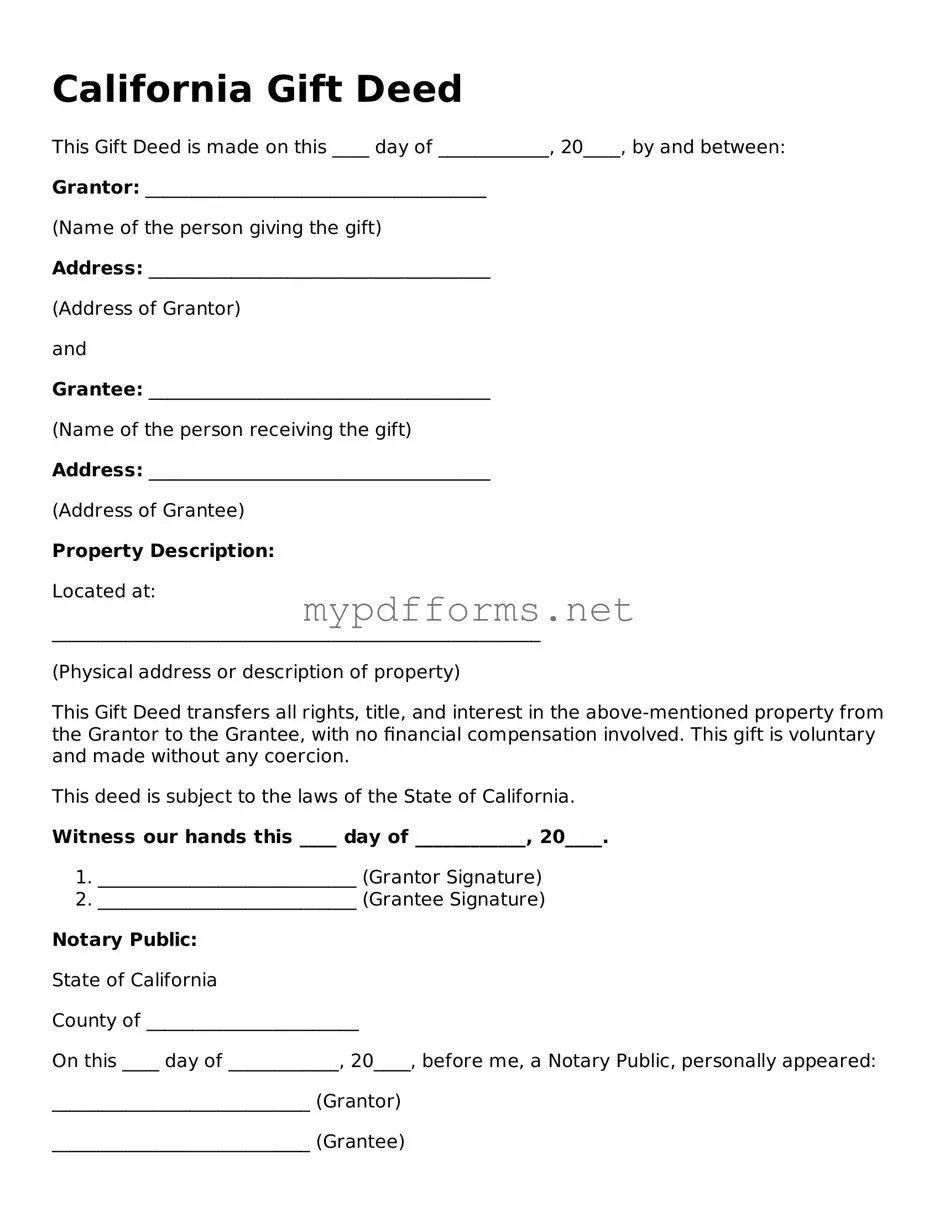The California Gift Deed form shares similarities with a Quitclaim Deed. Both documents serve to transfer ownership of property from one party to another without any warranties. A Quitclaim Deed is often used to relinquish any claim the grantor may have on the property, making it a straightforward option for transferring interests. Like the Gift Deed, it does not involve monetary exchange, but it is typically used in situations such as divorce settlements or transferring property between family members.
Another document similar to the Gift Deed is the Warranty Deed. While a Warranty Deed provides a guarantee that the grantor holds clear title to the property, it also serves to transfer ownership. Unlike the Gift Deed, which is used for gifts, the Warranty Deed is often used in sales transactions. However, both documents require the signature of the grantor and are recorded with the county to provide public notice of the ownership transfer.
When navigating the complexities of property ownership and transfer, it is essential to understand various legal documents such as the Gift Deed and others. Among them, for those in Illinois who are looking to ensure their transactions are clear and protected, the Illinois Forms can provide crucial templates and agreements to assist in the legal processes involved.
The Grant Deed is also comparable to the Gift Deed. A Grant Deed conveys property from one party to another and includes assurances that the grantor has not transferred the property to anyone else. While the Grant Deed typically involves a sale or exchange, it can also be used in gifting scenarios. The main distinction lies in the intent behind the transfer, as the Gift Deed explicitly states that the property is being given as a gift.
A Deed of Trust bears some resemblance to the Gift Deed in that it involves property transfer, but it serves a different purpose. A Deed of Trust is used to secure a loan, allowing a lender to hold a claim against the property until the borrower repays the debt. While the Gift Deed transfers ownership outright without any financial obligation, the Deed of Trust involves a conditional transfer based on the fulfillment of a loan agreement.
The Bargain and Sale Deed is another document that shares characteristics with the Gift Deed. This type of deed conveys property and implies that the grantor has the right to transfer the property, but it does not provide warranties regarding the title. While it is often used in sales transactions, it can also be employed in gifting scenarios, similar to the Gift Deed, where the grantor does not want to provide extensive guarantees about the property.
A Lease Agreement can also be likened to a Gift Deed in that it involves the use of property without a transfer of ownership. In a Lease Agreement, the landlord allows a tenant to use the property for a specified period in exchange for rent. While the Gift Deed involves a permanent transfer of ownership without compensation, both documents establish rights and responsibilities regarding property use.
The Power of Attorney is another document that may be compared to the Gift Deed. While it does not transfer property itself, a Power of Attorney allows one person to act on behalf of another in legal matters, including property transactions. If a person wishes to gift property but cannot be present, they may designate someone through a Power of Attorney to execute a Gift Deed on their behalf. Both documents require trust between the parties involved.
Finally, a Living Trust is similar to a Gift Deed in that it allows for the management and distribution of assets during a person’s lifetime and after their death. A Living Trust can facilitate the transfer of property without going through probate, much like a Gift Deed allows for a direct transfer of ownership. However, a Living Trust is typically more comprehensive, covering multiple assets and providing instructions for their management, while a Gift Deed focuses solely on the transfer of property as a gift.
